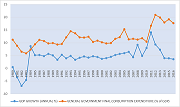Government Expenditure on Economic Growth: Empirical Evidence from Ghana

Abstract:
The role of the government
in a market economy cannot be underestimated. In reality, the public sector plays
significant role in an economy. Markets do fail sometimes, and for that reason,
government intervention is needed to provide public goods or handle externalities
and enforce competition in an economy. In the quest of government playing its role
in an economy, it faces the challenge of an appropriate level of government size
(government final consumption % of GDP) that can ensure sustained economic growth.
Data on government fiscal behavior in Ghana over the last two decades generally
shows a rising trend in government expenditure, yet the economic growth rate has
not risen commensurately. The study set out to provide additional empirical evidence
on the linkage between government size and economic growth in Ghana by a time series
data analysis and to test the optimal threshold level of which government final
consumption could lead to rapid growth in Ghana. The study concluded that total
government expenditure has a direct positive impact on economic growth. As a result
of that, the study recommended that government expenditure should not exceed the
optimum threshold level of 0.114% to maximize economic growth. The study,
therefore, advocates for fiscal discipline and control to keep government spending
at the optimal level so as to trigger a positive ripple effect to other sectors
of the economy and avoid a crowding out effect in the Ghanaian economy.
References:
[1] Heijdra, J.B. and Ploeg, V.D., 2002, The foundations of modern macroeconomics: Oxford University Press, USA.
[2] Mankiw, G., 2007, The role of economic growth in macroeconomics: MIT Press.
[3] Heinz, D. And Kurz, C.L., 2000, Input-output Analysis and Classical Economic Theory. Economic Systems Research, 12(2): 139-140.
[4] Nellis, J.G., and Parker, D., 2004, Principles of Economics, (1st ed.): Pearson Education Limited–England.
[5] Solow, Robert M., 1956, “A contribution to the theory of Economic Growth”. Quarterly Journal of Economics, Vol. LXX.
[6] Sinha, D., 1998, Government Expenditure and Economic Growth in Malaysia. Journal of Economic Development, Vol. 23, Number 2, pp. 71-80.
[7]
Henrekson, M., 1993, Wagner’s Law
– a Spurious relationship. Public Finance,
48, pp. 406-415.
[8]
Slemrod, J., Gale, W. and Easterly,
W.,1995, What do Cross-Country Studies Teach about Government Involvement, Prosperity,
and Economic Growth, Brooking Papers on Economic Activity, (2), pp. 373-431.
[9]
Branson, W. H. 1989, Macroeconomic Theory and Policy, 3rd ed., New
York: Harper & Row.
[10] Afonso, A. and Jalles, J. T. 2011,
Economic performance, and government size. Working Paper Series 1399 / November
2011. European Central Bank, 2011, Frankfurt.
[11]
Asimakopoulos, S. and Y. Karavias, 2015, The impact of government
size on economic growth: A threshold analysis (2015), Economics Letters, http://dx.doi.org/10.1016/j.econlet.2015.12.010.
[12]
Caselli, F., Esquivel, G., and Lefort,
F.,1996, Reopening the convergence debate: A new look at cross-country growth empirics,
Journal of Economic Growth 1(3): 363–389.
[13]
Romero-Ávila, D., and R. Strauch
(2008). Public finances and long-term growth in Europe: Evidence from a panel data
analysis, European Journal of Political Economy
24(1): 172-19.
[14] Bose, N., M. E. Haque, and D. R., Osborn (2007). Public expenditure and
economic growth: A disaggregated analysis for developing countries, The Manchester School 75(5): 533-556.
[15] Guseh, J., 2007, Government size and economic growth in developing countries:
A political-economy framework. Journal of
Macroeconomics 19(1): 175-192.
[16]
Gray, C., T. Lane, and Varoudakis,
A., 2007, Fiscal policy and growth in ECA: Lessons for Eastern Europe and Central
Asia. Washington DC: The World Bank.
[17]
Oto-Peralías, D. and Romero-Ávila, D., 2013, Tracing the link between government size and growth: The role of public sector
quality. KYKLOS 66(2): 229–255.
[18]
Sheehey, E.,1993, The effect of
government size on economic growth. Eastern
Economic Journal 19(3): 21–328.
[19]
Durden, G. and Elledge, B. (n.d.), The effect of government size on economic growth:
evidence from gross state product data. The Review of Regional Studies: 183–190.
[20]
Meltzer, A. H., and Richard, S.
F., 1981, A rational theory of the size of government. Journal of Political Economy. 89(5): 914–927.
[21]
Zhu, Z, Chiou-Wei, S and Kuo, Y.,
2010, Government size and economic growth: an application of the smooth transition
regression model. Applied Economics Letters
17(14), 1405 – 1415.
[22] Altune, O.F., and Aydin, C, 2013, The
relationship between the optimal size of government and economic growth: Empirical
evidence from Turkey, Romania, and Bulgaria. Procedia-social and Behavorial sciences, 92, 66-75.
[23]
Chen, S.T., and Lee, C.C, 200, Government
size and economic growth in Taiwan: A threshold regression approach. Journal of policy modelling 27(9), 1051-1066.
[24]
Karras (1997) Karras, B.E, 1999, Threshold effects in non-dynamic
panels: estimation, testing, and inference. Journal
of Econometrics, 93, 345-68.

